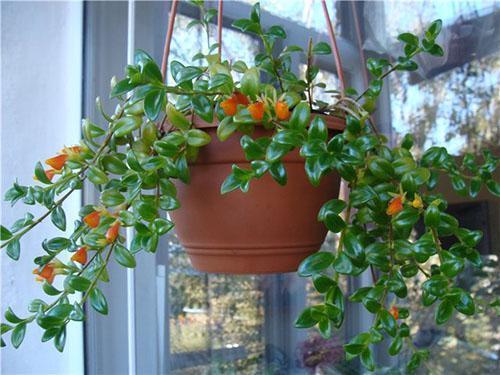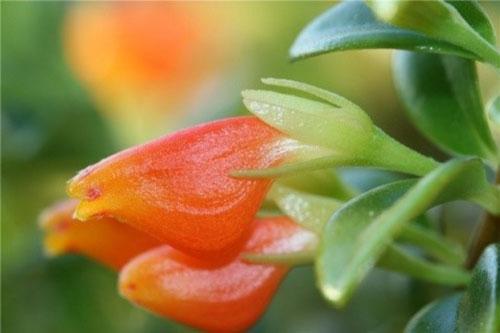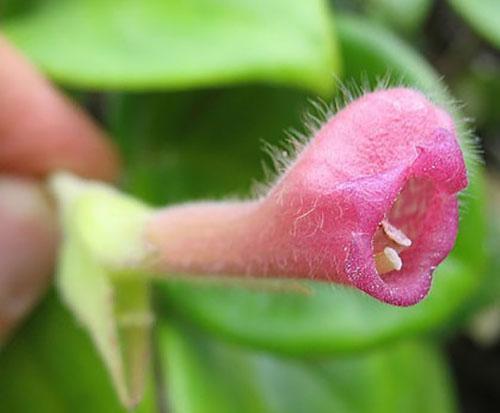What types of nematanthus are grown at home
 Nematantus or hypocyrta is a plant that belongs to the Gesneriaceae family. Both shrub and herbaceous forms are found in nature. There are 28 varieties in total. Some types of nematanthus can also be grown at home.
Nematantus or hypocyrta is a plant that belongs to the Gesneriaceae family. Both shrub and herbaceous forms are found in nature. There are 28 varieties in total. Some types of nematanthus can also be grown at home.
Nematantus Vetstein

The bloom is profuse and lasts from April to September. A large number of red-orange flowers bloom on the plant.
Nematantus Fritsch
 A distinctive feature of this type of nematanthus is the color of the leaves. Its underside has a reddish tint. The top side is a rich green with an eye catching sheen. The length of one sheet does not exceed 7.5 cm.
A distinctive feature of this type of nematanthus is the color of the leaves. Its underside has a reddish tint. The top side is a rich green with an eye catching sheen. The length of one sheet does not exceed 7.5 cm.
Nematantus Fritsch can reach a height of 60 cm. Thin shoots are heavily pubescent. During the flowering period, pink flowers of a bright or slightly muted shade bloom on them. They are funnel-shaped. The size of one flower is no more than 5 cm.
Riverine nematantus
 The plant belongs to the climbing species, that is, it likes to climb up, holding on to the support. It does not exceed 25 cm in height. The stem does not branch. On it, the leaves of the epileptic form are located opposite. Their length varies from 5 to 10 cm. They are colored bright green. The reverse side of the leaves has a reddish tint.
The plant belongs to the climbing species, that is, it likes to climb up, holding on to the support. It does not exceed 25 cm in height. The stem does not branch. On it, the leaves of the epileptic form are located opposite. Their length varies from 5 to 10 cm. They are colored bright green. The reverse side of the leaves has a reddish tint.
Long and rather thin peduncles grow from the axils of the leaves. There can be up to three of them. Lemon-yellow flowers are formed on them. Their size does not exceed 5 cm. In shape, the flowers resemble a funnel, one side of which is swollen. Riverine nematantus blooms profusely from April to September.
This type of plant is well suited for growing at home.
Nematanthus ankle
 Ankle nematanthus is a type of epiphytic climbing shrubs. On the shoots, large leaves are located opposite. They can be up to 10 cm long and 4 cm wide. They are painted in an attractive light green color. Smooth, no pubescence.
Ankle nematanthus is a type of epiphytic climbing shrubs. On the shoots, large leaves are located opposite. They can be up to 10 cm long and 4 cm wide. They are painted in an attractive light green color. Smooth, no pubescence.
One or more pedicels emerge from the axils of the leaves. Their length can reach 10 cm. Single flowers open on them. They have a peculiar funnel shape with a slight bulge on the side. The calyx is dissected and thus divided into five segments of small width. The petals are colored scarlet red.
Nematanthus small-bristled
It is one of the most compact nematanthus species. Its height does not exceed 25 cm. The plant is evergreen, therefore, does not shed foliage. The leaves of the plant are rich green.
During the flowering period, the small-bristled nematanthus is covered with bright buds, which in shape resemble a ball on a small tube. They are colored reddish orange.
Nematanthus naked
 The plant is of the semi-ampel type. Its shoots are erect at the base, and droop closer to the top. Virtually no branching. The branches are strewn with a large number of fleshy leaves. They have a regular elliptical shape. Their length does not exceed 4 cm.
The plant is of the semi-ampel type. Its shoots are erect at the base, and droop closer to the top. Virtually no branching. The branches are strewn with a large number of fleshy leaves. They have a regular elliptical shape. Their length does not exceed 4 cm.
Peduncles emerge from the axils of the leaves. Their number can vary from one to three. A beautiful flower of bright orange color blooms on the peduncle. Nude nematantus blooms sparingly.
Nematanthus coin
 The monetary nematanthus received this name due to the shape of its leaves and flowers. They have a round shape that looks like a coin. The leaves are small, not more than 2 cm in diameter, fleshy. Their surface is covered with small hairs. Colored light green.
The monetary nematanthus received this name due to the shape of its leaves and flowers. They have a round shape that looks like a coin. The leaves are small, not more than 2 cm in diameter, fleshy. Their surface is covered with small hairs. Colored light green.
The plant is ampelous. Possesses long, spreading shoots. During flowering, the hypocyrt becomes covered with small flowers. Their petals are bright red. They have a yellow corolla.
A distinctive feature of this plant is that after flowering it completely sheds its leaves. In spring, fresh leaves bloom on the shoots.
Short-haired nematanthus
 Spectacular fast growing plant. Short-haired nematanthus has erect stems that practically do not branch. Most of the leaves are concentrated at the top of the shoots. This is due to the fact that in the wild, the plant is adjacent to tall grasses. Because of this, the decorative characteristics of hypocyrtes suffer.
Spectacular fast growing plant. Short-haired nematanthus has erect stems that practically do not branch. Most of the leaves are concentrated at the top of the shoots. This is due to the fact that in the wild, the plant is adjacent to tall grasses. Because of this, the decorative characteristics of hypocyrtes suffer.
During the flowering period, the plant is covered with unusual yellow flowers. The petals are covered with microscopic villi. At the base, they have a small purple cup. The leaves are opposite. They grow on long, dark reddish cuttings.
Nematantus corticolla
 One of the largest members of the family. Nematanthus korticikola in height can reach 1.2 meters. Feels good in partial shade. Stems are thin enough, branched. The leaves of the plant are large enough. Painted dark green. In the wild, it is most often found in eastern Brazil. Likes to hide among trees or in rocky areas.
One of the largest members of the family. Nematanthus korticikola in height can reach 1.2 meters. Feels good in partial shade. Stems are thin enough, branched. The leaves of the plant are large enough. Painted dark green. In the wild, it is most often found in eastern Brazil. Likes to hide among trees or in rocky areas.
Large clusters of spectacular flowers become a distinctive feature of the plant. They hang down on long peduncles. The size of each flower does not exceed 5 cm. They have an attractive red-scarlet color.
Nematanthus tropical
 Nemantanthus tropical or tropicana is a tall plant with a thin, strongly branching stem. The leaves on the shoots are opposite. They are oval in shape. The edge is slightly pointed. The leaves have an attractive glossy sheen.
Nemantanthus tropical or tropicana is a tall plant with a thin, strongly branching stem. The leaves on the shoots are opposite. They are oval in shape. The edge is slightly pointed. The leaves have an attractive glossy sheen.
During flowering, small flowers bloom on the plant. They have an unusual color. Golden stripes stand out against a pleasant orange-yellow background.
Nematantus gregarius
 This is the most popular type of hypocyrt. It is popularly called the "goldfish". This name stuck to the plant due to the unusual shape and color of the flowers. They vaguely resemble small goldfish that are bred in an aquarium. There are varieties with yellow and orange flowers.
This is the most popular type of hypocyrt. It is popularly called the "goldfish". This name stuck to the plant due to the unusual shape and color of the flowers. They vaguely resemble small goldfish that are bred in an aquarium. There are varieties with yellow and orange flowers.
Nematanthus gregarius is covered with small oval leaves. Their edge is slightly pointed. They have a glossy dark green surface. Shoots are creeping, therefore, the plant belongs to the ampel type.
Nematanthus variegated
 This type of hypocyrta is distinguished by a double leaf color. Their surface can be rich green with a light center or a white border around the edge. May have streaks a couple of shades lighter than the main color.
This type of hypocyrta is distinguished by a double leaf color. Their surface can be rich green with a light center or a white border around the edge. May have streaks a couple of shades lighter than the main color.
The flowers of the plant are shaped like a ball on a hollow tube. Painted in a pleasant orange color.
Nematantus has a large number of varieties. Suitable for home cultivation are Gregarius, riverine and tropical hypocyrt. With proper care and favorable conditions, the plant will delight you for a long time with its spectacular appearance and violent flowering.